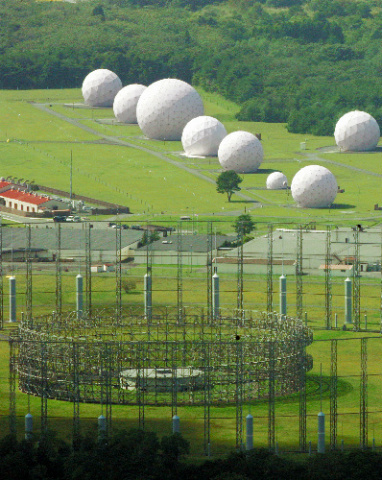The Wullenweber Array (CDDA): An Era Of Intelligence Gathering
The Wullenweber was a monster sized antenna invented by Dr. Hans Rindfleisch, which was informally called the elephant cage. The elephant cage or Circularly Disposed Dipole Array (CDDA), was circular and was used for spying. Was the elephant cage antenna the predecessor of HAARP?
The elephant cage was used by the US military for intelligence, but was originally developed by the German Navy. It was very large, expensive, and impractical for the average amateur radio operator.
“Professor Edgar Hayden, then a young engineer in the University of Illinois Radio Direction Finding Research Group, led the design and development of a large Wullenweber array at the university’s Bondville Road Field Station, a few miles southwest of Bondville, IL. The array consisted of a ring 120 vertical monopoles covering 2-20 MHz. Tall wood poles supported a 1,000-foot-diameter circular screen of vertical wires located within the ring of monopoles. Due to their immense size, the location of the array (40.0494°N 88.3807°W) and the other post-war arrays are clearly visible on the internet.”
Edward C. Jordan participated in nine books and published numerous articles. His popular textbook, Electromagnetic Waves and Radiating Systems, was first published in 1950.
Jordan’s follow-up book was Electromagnetic Waves and Radiating Systems Second Edition.
Wullenweber research lasted for more than 25 years and the US Navy constructed systems around the world.
“The ring of poles is an elaborate radio antenna system that was developed for the US Navy in the 1950’s and 60’s by the Electrical Engineering Department of the University of Illinois in the farmland a few miles southwest of Bondville, about five miles west of Champaign, Illinois. Following the completion of the University’s development work, the Bondville installation, known as the Bondville Road Field Station (BRFS), was abandoned in approximately 1980, partially dismantled in the 1990’s, and in 2003, was completely dismantled.”
The Elephant Cage Timeline
Recent Posts
- Clothoff: Understanding DeepNude Co and Its Impact on Digital Ethics
- Clothoff: The Revolutionary AI Undress App
- Probeer HolyLuck Casino Vandaag: Spannende Kansen om Jackpot te Behalen met Baccarat
- Probeer HolyLuck Casino Vandaag: Gids voor Spannende Poker Direct Beschikbaar
- Ontdek HolyLuck Casino: Tips voor Ongelooflijke Tafelspellen Deze Maand

2 Responses
youtube mp3 dönüştürücü
July 10th, 2013 at 8:40 am
1…
arabesk rap
July 13th, 2013 at 12:58 pm
2thank you …
RSS feed for comments on this post · TrackBack URI
Leave a reply
Subscribe to Feed
Subscribe Now!
Featured Deal ➸
Social Button ➸
Categories
Archives
SQUIDBOARD
Academic Tech
Multimedia MegloMania
Tech Toolbox
Meta
Navigate the Night Sky like Galileo ➸
Popular Squids ➸
2. HDMI To RCA Composite Enables Users To Stream With Old TVs ... On The Squid ► If you’re wanting to stream content with a device such as Apple TV for example, but you do not have a flat screen TV, there’s a gadget that you might be interested in. The HDMI to RCA composite enables users to stream with the old style television. Yes, Apple fans can watch Apple TV with that old TV. Chromecast is another viable choice.
3. Roku Purple Light Keeps Blinking ... On The Squid ► The Roku set top box updates itself often. Not long after a reset I noticed one of the Roku boxes was doing something rather odd. The purple light continued to blink and it wouldn’t stop. The Roku unit worked great, but the purple light kept blinking. The light should not be blinking all of the time.
4. The NooElec Dongle Is Too Much Fun! ... On The Squid ► For around $20, the NooElec Dongle is way too much fun! It’s not for everybody, but for the tech that doesn’t mind spending a little time with it, the benefits pay off.
5. The Big Zapper: All Band Doublet ... On The Squid ► Uses 96 feet quarter wave, or per leg. Copper wire (solid) preferred is AWG #14 or #12. Width is 192 feet total.
6. How To Program Baofeng UV5R ... On The Squid ► New out of the box—one must learn to program your Baofeng UV-5R radio. This guide is useful especially for newbies. I’m mostly interested in programming simplex type applications, along with local emergency frequencies.
7. Cheaper Wire For Ham Antenna Projects ... On The Squid ► Especially for listening to the lower bands in this crazy unpredictable solar cycle, I’m accustomed to building my own antennas. Thicker copper wire is usually the standard, but over the years I’ve learned that thinner gauge wire will hold out sufficiently. It’s all in the packaging. Here are a few scattered ideas.
8. Live Police Scanner Feeds On Your Computer ... On The Squid ► Want to listen to live streaming radio transmissions of police, fire, and EMS in your area? Do you own a computer with internet access? If so, you now have a police scanner. Listen to live audio online in the United States.
9. Kenwood 590 EQ Settings ... On The Squid ► The Kenwood TS-590S EQ settings will give the user optimum TX audio if properly configured. This transceiver is hard to beat for the money. Some will use the default mode, while others take the benefit of the ARCP-590 software. Follow this and you will have sparkle and articulation.
10. The Guide to Setting Up Google Chromecast ... On The Squid ► Setting up Chromecast is a simple process for the most part, and the reward is worth it. Just follow along with my guide and you’ll get your Chromecast going. If you have trouble with setup you can leave a comment and I will do what I can to help.
Poll ➸